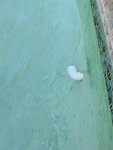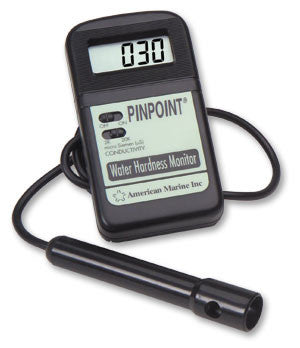- May 3, 2007
- 18,112
- Pool Size
- 20000
- Surface
- Plaster
- Chlorine
- Salt Water Generator
- SWG Type
- Hayward Aqua Rite (T-15)
I would also keep your testing to the spa since that would reduce the test period and help reduce any algae influence
Assuming 24 volts DC and 6 amps, it’s like there are 2 sets of (6) 4volt batteries in series being charged with the sets in parallel. The total amps are 6 amps x 6 cells or 3 amps x 12 cells (36 amps either way).Something doesn't add up for me.
An electrode pulling 6.5A for 24 hours should only be able to produce 0.45 lbs of chlorine per day, and that's assuming all electrons involve a chloride anion. Where am I going wrong? It's even worse if we're generating ClO2.
- 6.5A x 24 hours is 156Ah.
- 1 mole of electrons is 26.8Ah (96,485 Coulombs).
- 156Ah / 26.8Ah = 5.82 mol e-
- 1 mole of CL2 requires 2 moles of electrons to produce (two Cl- anions).
- 5.82 moles of electrons produces 2.91 moles of Cl2.
- The molar mass of Cl2 is 70.906 g/mol.
- 2.91 moles of Cl2 is 206 g, or 0.45 lbs.
I'm not raising to shock levels. The last OCLT I ran was starting the evening at 5.6 and 5.4 in the morning if I recall correctly. Otherwise, that's how I'm doing it.It surprising to me that you can pass OCLT with active mustard algae growth....are you raising your FC to shock levels, turning off all sources of chlorine, measuring at night and then remeasuring in the morning before sun up? Preferably using a deep water sample collected using a pipe, not just a surface sample...
Absolutely easier. 3.1 lbs of chlorine per day would raise the spa about 28 per hour, but it's only raising it 8 per hour. There's no way algae is consuming the other 20. At that rate the pool would consume 22 gallons of 12.5% a day.I would also keep your testing to the spa since that would reduce the test period and help reduce any algae influence


The main reason is that if the SWG isn't going to produce its advertised output (or even somewhere north of 70% or so), it's not staying in the pool. I am not keen on making my life that much more miserable with liquid chlorine. If I can get it to perform as advertised I will raise CYA. The bag of CYA is sitting in the garage waiting to go. Draining around 50% of my pool would take about two days, too. Something I'm not eager to do.I still think your CYA is too low which to me as per TFP isn't recommended. Why wouldn't you bring the CYA upto recommended levels.
Question: When the SWG first starts, the instantaneous salt reading will be very high (like over 5,000). As it runs for the next 20 or 30 minutes the instantaneous salt reading slowly falls down to the 3800 ppm range. The average salt displays 3800 as well. Is that 5,000+ at start up each time normal?

My meter doesn't have TDS. It's just strictly a conductivity meter.

PINPOINT® Freshwater Hardness Monitor
PINPOINT® Freshwater Hardness Monitor is an instrument for the measurement of hardness in freshwater. The conversions are 33 µS=17.9 ppm=1dH. Good quality reverse osmosis water measures 5–15 µS, while de-ionized water typically measures 0–1 µS. The Freshwater Hardness Monitor is automatically...americanmarineusa.com
According to that chart, my salinity is around 4,500. Why would the controller read 15% lower? Perhaps more importantly, if my salinity really was 4500, would that reduce chlorine production by about 70% or would it increase it by having more chloride available to electrolyze?

